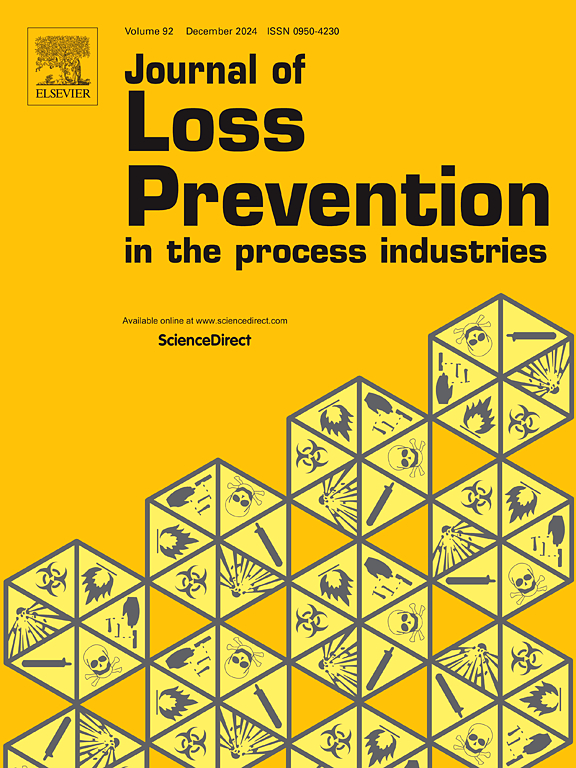Simulation exploration on the interaction between hydrogen/air explosion overpressure and flame morphology under different initial pressures
IF 3.6
3区 工程技术
Q2 ENGINEERING, CHEMICAL
Journal of Loss Prevention in The Process Industries
Pub Date : 2025-02-05
DOI:10.1016/j.jlp.2025.105567
引用次数: 0
Abstract
This work explores the flame morphology, pressure field, and velocity field near the flame surface in H/air explosion under different initial pressures, by resorting to numerical simulations. Their interaction effects are revealed and analyzed in detail, which is hard in real-constrained experiments. The results demonstrate that the flame wrinkling factor increases along time in the magnitude of -degree power. The correlation between its temporal rise rate and initial pressure can be reflected by power function. In addition, it can seen that the trend of wrinkling factor with time is similar to that of explosion overpressure at different equivalence ratios. When the wrinkling factor reaches maximum, the rate of pressure rise is biggest. Like flame surface, the isobaric surfaces near the flame surface also wrinkle. Many concave pressure waves appearing after the convex flame surface disturb the flow in burnt zone. Moreover, it can be found that along time, the increasing pressure difference before and after the flame surface will lead to gas decelerating and then reversely accelerating. When the overpressure increases more quickly, the backward gas velocity goes up faster. Note that the backward velocity after convex flame surface is larger than that after concave flame surface.

不同初始压力下氢气/空气爆炸超压与火焰形态相互作用的模拟探索
本文通过数值模拟的方法研究了不同初始压力下H2/空气爆炸火焰的形态、火焰表面附近的压力场和速度场。详细地揭示和分析了它们的相互作用效应,这在实际约束实验中是很难做到的。结果表明,随着时间的推移,火焰起皱系数以n度功率的量级增加。其时间上升速率与初始压力之间的相关关系可以用幂函数来反映。此外,可以看出,在不同当量比下,起皱系数随时间的变化趋势与爆炸超压的变化趋势相似。当起皱系数达到最大时,压力上升速率最大。像火焰表面一样,靠近火焰表面的等压面也会起皱。凸起的火焰面后出现许多凹形压力波,干扰了燃烧区内的流动。而且可以发现,随着时间的推移,火焰表面前后压力差的增大会导致气体先减速后反向加速。超压增大越快,反向气速增大越快。注意,凸面火焰后的反向速度大于凹面火焰后的反向速度。
本文章由计算机程序翻译,如有差异,请以英文原文为准。
求助全文
约1分钟内获得全文
求助全文
来源期刊
CiteScore
7.20
自引率
14.30%
发文量
226
审稿时长
52 days
期刊介绍:
The broad scope of the journal is process safety. Process safety is defined as the prevention and mitigation of process-related injuries and damage arising from process incidents involving fire, explosion and toxic release. Such undesired events occur in the process industries during the use, storage, manufacture, handling, and transportation of highly hazardous chemicals.

 求助内容:
求助内容: 应助结果提醒方式:
应助结果提醒方式:


